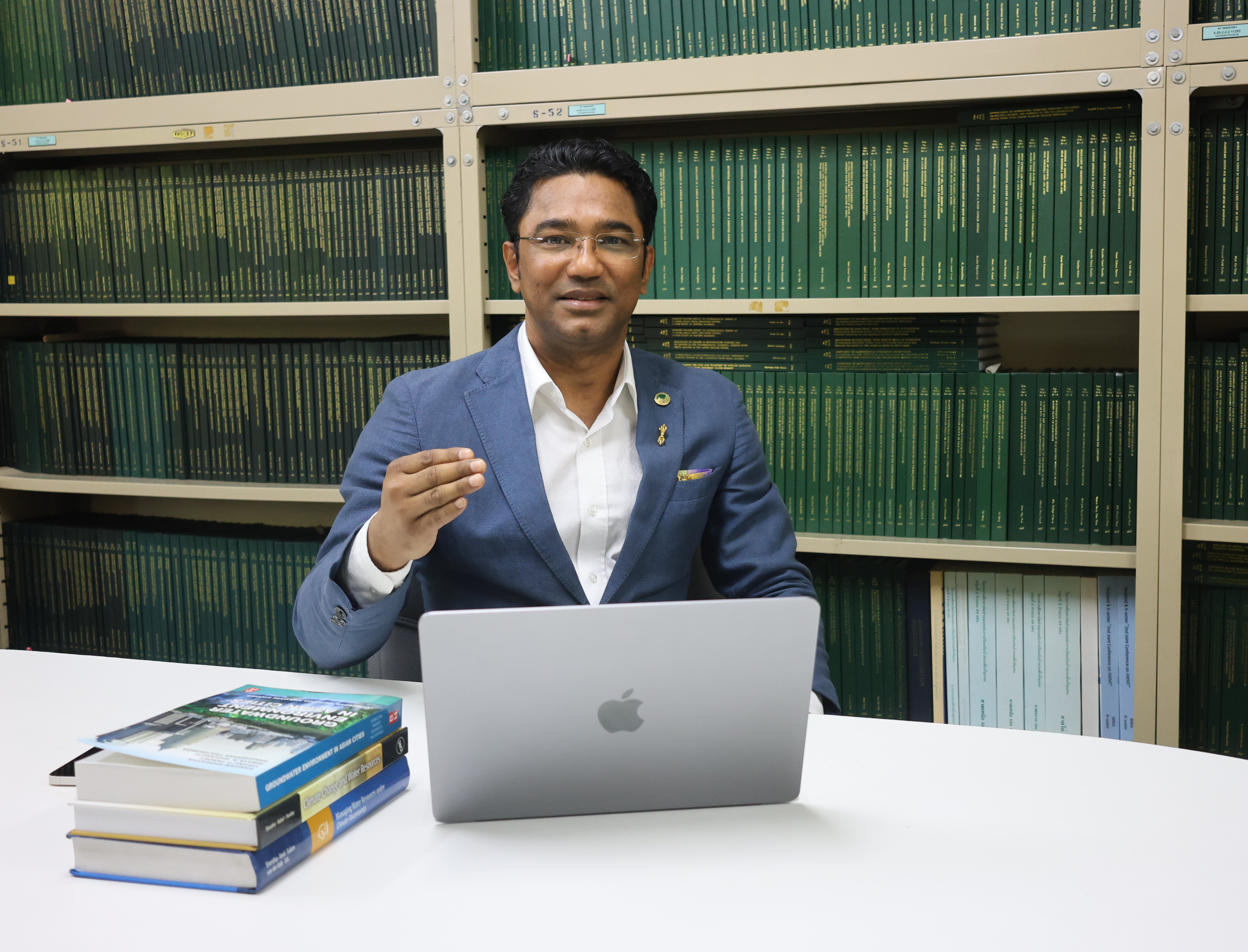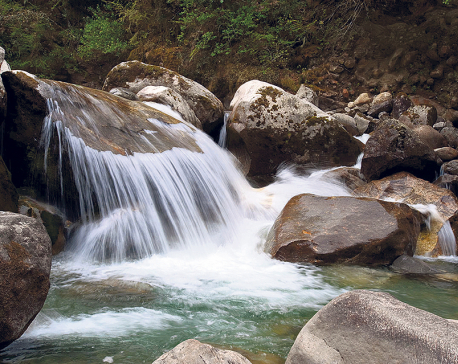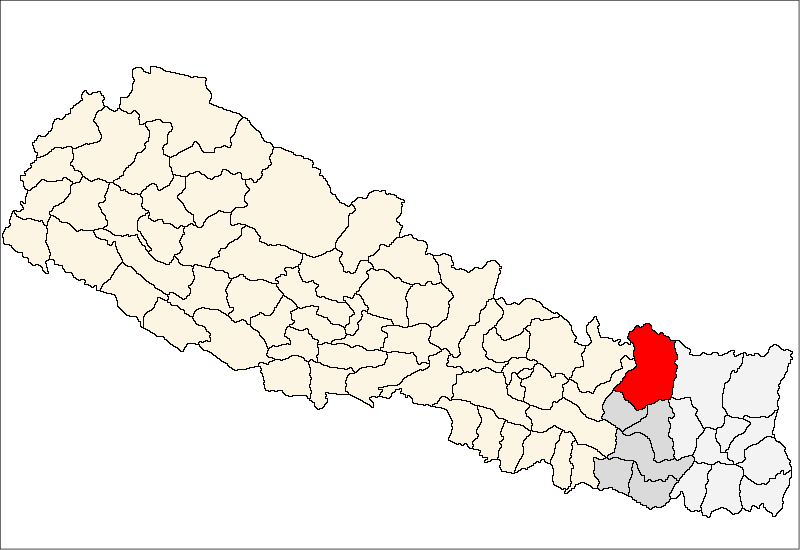
OR
Republica Interview
Changes in precipitation patterns affecting crop production and food security in Nepal
Published On: December 24, 2023 08:00 AM NPT By: Republica | @RepublicaNepal

‘Overexploitation of groundwater is leading to declining water tables in some regions of Nepal’
Prof. Dr. Sangam Shrestha is the Dean of the School of Engineering and Technology and Professor of Water Engineering and Management at the Asian Institute of Technology, Thailand. He is also the founding Co-Director of Global Water and Sanitation Center at AIT. Dr. Shrestha is also a Visiting Professor of Beijing Normal University in China, University of Yamanashi, Japan, National University of Laos, and SEI Associate of Stockholm Environment Institute (SEI). His research interests are within the field of hydrology and water resources including, climate change impact assessment and adaptation in the water, integrated water resources management and groundwater assessment and management. Dr. Shrestha has published more than 200 papers in peer-reviewed international journals and presented more than 100 conference papers ranging from hydrological modelling to climate change impacts and adaptation in the water sector. Dr. Shrestha has been awarded the ‘Distinguished Research Leader Award’ in 2015 and 2019 at AIT. Most recently, he has been named as one of the ‘World's Top Climate Scientists’ in the ‘Reuters Hot List’ that identifies and ranks 1,000 climate academics according to how influential they are. Additionally, his name appeared in the ‘World’s Top 2% list of Scientists’ for research impact based on the most recent single year and career long achievement in a paper published by Stanford University researchers in PLOS Biology in 2020, 2021 and 2022. Republica’s Editor Kosh Raj Koirala talked to Dr Shrestha on various issues including climate change and its impacts in Nepal, measures to enhance Nepal's resilience to climate change impacts and various issues of water resource management in Nepal. Excerpts:
Republica: Nepal is highly vulnerable to climate change. Could you elaborate on the specific climate change impacts that Nepal is currently facing, particularly in the context of water resources and sanitation?
Prof. Dr. Shrestha: Nepal, located in the Himalayan region, is experiencing significant impacts of climate change, particularly concerning water resources and sanitation. One of the key issues Nepal faces now is glacial melting and Glacial Lake Outburst Floods (GLOFs): Nepal's Himalayas have numerous glaciers that are melting at an accelerated rate due to global warming. This not only leads to the formation of new glacial lakes but also increases the risk of GLOFs, which can release millions of cubic meters of water and debris, devastating downstream communities and infrastructure. Similarly, water scarcity and quality are other important issues. The melting glaciers initially increase water flow in rivers, but over time, as glaciers recede, the flow decreases, leading to water scarcity. This scarcity is particularly problematic in the dry season. Furthermore, changing precipitation patterns affect the availability and quality of water, impacting both drinking water supply and agriculture.
The impacts of climate change are visible in agriculture. Agriculture in Nepal relies heavily on seasonal rainfall and snowmelt from the Himalayas. Changes in precipitation patterns and the reduced snowpack in mountains lead to irregular and unpredictable water availability, affecting crop production and food security. Climate change has led to more extreme weather events, including intense rainfall. This increase in heavy rainfall events elevates the risk of floods and landslides, which can contaminate water sources and damage sanitation infrastructure. Furthermore, in some regions of Nepal, there is an increased occurrence of droughts, further exacerbating water scarcity. Over-reliance on groundwater during these periods leads to depletion of aquifers, and the reduced recharge rates due to irregular rainfall worsen the situation.
Nepal equally faces challenges in the front of sanitation. Inadequate water supply hampers sanitation facilities. The contamination of water sources due to floods and landslides poses risks to public health, as it does by inadequate sanitation infrastructure. The changing climate is also affecting the ecosystems and biodiversity in Nepal, with shifts in the distribution of flora and fauna, affecting biodiversity and the services ecosystems provide, including water filtration and regulation. Furthermore, the impacts on water resources and sanitation have broad socioeconomic implications. They affect not only public health and agriculture but also energy production (hydropower), livelihoods, and the overall economy. Addressing these challenges requires integrated water resource management, investment in resilient infrastructure, community-based adaptation strategies, and international cooperation, particularly in terms of knowledge sharing and financial support for climate adaptation and mitigation efforts.
As a renowned expert in climate change, water engineering and management, how do you see the potential for collaboration between the Asian Institute of Technology (AIT), Thailand and institutions in Nepal to address climate change challenges?
As an expert in water engineering and management, I see significant potential for collaboration between the Asian Institute of Technology (AIT) in Thailand and institutions in Nepal to address the challenges posed by climate change, particularly in water resources and sanitation. Here are some key areas where such collaboration could be highly beneficial. One of the areas in which we could collaborate is research and innovation. AIT is renowned for its advanced research in water engineering and environmental management. Collaborating with Nepalese institutions can lead to joint research projects focusing on Himalayan hydrology, glacial dynamics, sustainable water management, and climate-resilient infrastructure. These projects can provide valuable insights and innovative solutions specifically tailored to the unique challenges faced by Nepal.
Similarly, we can forge collaboration on knowledge and technology transfer. AIT can play a pivotal role in transferring cutting-edge technologies and methodologies to Nepalese institutions. This could involve the use of advanced modeling tools for predicting climate impacts, water resource management techniques, and sustainable sanitation solutions. Sharing these technologies can enhance Nepal's capacity to manage its water resources more efficiently and adapt to climate change.
I believe we can also work together on capacity building and education. Collaborative programs in education and training can be established to enhance the skills and knowledge of professionals and students in Nepal. This could include specialized training programs, workshops, and exchange programs focusing on climate change adaptation, water resource management, and environmental protection. Furthermore, AIT and Nepalese institutions can collaborate on developing effective policies and strategies for water resource management and climate change adaptation. This collaboration can also extend to implementing these policies at local, regional, and national levels, ensuring they are well-suited to Nepal's specific needs and conditions.
We can also make joint efforts to mobilize funding from international donors, NGOs, and governments for research, infrastructure development, and community projects. Collaborative grant applications and fundraising efforts can be more effective in securing the necessary resources for large-scale projects. Above all, by working together, AIT and Nepalese institutions can become a strong regional voice in advocating for climate change adaptation and sustainable water management. They can collaborate on regional forums and platforms to highlight the challenges faced by the Himalayan region and seek collaborative solutions. The potential for collaboration between AIT and Nepalese institutions is vast and multifaceted. Such partnerships can significantly contribute to developing resilient, sustainable, and effective solutions to the challenges posed by climate change in Nepal, benefiting both the environment and the local communities.
Given your extensive experience in water resources, how do you assess the current state of water and sanitation in Nepal, and what key improvements or interventions do you think are essential for sustainable development?
Nepal's water and sanitation sector faces challenges that require urgent, multi-faceted interventions for sustainable development. Key areas for improvement include upgrading water infrastructure, enhancing sanitation facilities, ensuring sustainable water resource management, and adapting to climate change. Promoting equity and inclusivity in access to water and sanitation, strengthening policy and governance, enhancing public education and awareness, leveraging technology and research, and forging international collaboration, as well as finding financial resources for large-scale projects, are equally critical in this regard. Through these interventions, Nepal can make significant strides toward sustainable water and sanitation development, benefiting public health, the economy, and the environment.
Water, Sanitation, and Hygiene (WASH) are critical for public health. What role do you see for AIT and other international organizations in supporting WASH initiatives in Nepal, especially in the context of rural areas?
The Asian Institute of Technology (AIT) and other international organizations play a pivotal role in supporting Water, Sanitation, and Hygiene (WASH) initiatives in Nepal, especially in rural areas where these services are often lacking. Their involvement can significantly improve public health and contribute to sustainable development. Firstly, AIT and international organizations can aid in capacity building and training. They can conduct programs for local engineers, health workers, and community leaders, focusing on sustainable water management, sanitation infrastructure development, and hygiene promotion tailored to the specific challenges of rural Nepal. Additionally, they can contribute to technology transfer and innovation by introducing advanced, cost-effective, and sustainable technologies for water purification, waste treatment, and sanitation. They can also support research and development initiatives suitable for the rural context of Nepal, such as low-cost water filtration systems, eco-toilets, and rainwater harvesting methods.
Policy Support and Advocacy are other critical areas where they can assist Nepal. AIT and its partners can help the Nepalese government in developing and implementing effective WASH policies, providing expert advice, research data, and best practice examples from other regions. International organizations often have access to funding sources that can be mobilized for WASH projects, assisting in securing financial support for large-scale initiatives, including grants and low-interest loans.
AIT and other international organizations can further aid in partnerships and networking. By fostering collaborations between governmental bodies, NGOs, local communities, and the private sector, they can create a network that strengthens WASH initiatives, facilitating the sharing of knowledge, resources, and best practices. These institutions can also assist in implementing robust monitoring and evaluation frameworks to ensure the effectiveness and sustainability of WASH programs, providing expertise in setting up such frameworks and conducting regular assessments to track progress and impact. I firmly believe that AIT and international organizations play a critical role in enhancing WASH initiatives in rural Nepal, addressing the unique challenges of these areas and leading to significant improvements in public health and quality of life.
Groundwater plays a crucial role in sustaining water resources. Could you share insights into the current status of groundwater assessment and management in Nepal, and how advancements in this area can contribute to climate resilience?
Groundwater is a crucial component for sustaining water resources, especially in countries like Nepal, where surface water availability can be seasonally variable. However, groundwater assessment in Nepal is still in its early stages, marked by a lack of comprehensive data on groundwater levels, recharge rates, and aquifer capacities. This knowledge gap poses challenges in effectively managing groundwater resources, with an increasing reliance due to the unpredictability of surface water sources, particularly for irrigation and drinking water in both rural and urban areas. In some regions, there's a concerning trend of overexploitation, leading to declining water tables, compounded by contamination from agricultural runoff, industrial effluents, and inadequate sanitation.
Advancements in groundwater assessment technologies, such as remote sensing, GIS mapping, and hydrogeological models, can provide a more accurate understanding of groundwater resources, crucial for sustainable management. Adopting Integrated Water Resource Management (IWRM) approaches that incorporate groundwater can help balance surface and groundwater use, ensuring more sustainable and equitable water resource distribution. Recharge and conservation initiatives, including rainwater harvesting, check dams, and recharge wells, are vital for maintaining groundwater levels. Efficient irrigation practices can further reduce strain on groundwater resources.
Equally critical are policy and regulation advancements in groundwater management. Developing and enforcing robust policies for extraction limits, water quality monitoring, and pollution control are essential. Engaging local communities and raising awareness about groundwater conservation contribute to sustainable practices and local stewardship. Research collaborations between Nepalese institutions and international partners can drive innovations in groundwater management, fostering the exchange of knowledge and best practices globally. Advancing groundwater assessment and management is imperative for Nepal to build climate resilience, providing a buffer during periods of water scarcity and contributing to the overall stability of water resources. This necessitates a coordinated effort involving technology, policy, community engagement, and international collaboration.
Nepal is actively working on climate change adaptation strategies. From your perspective, what are some innovative approaches or technologies that can enhance Nepal's resilience to climate change impacts, particularly in the water sector?
Nepal's efforts to adapt to climate change, especially in the water sector, can be significantly strengthened by innovative approaches and technologies. These innovations not only help cope with the immediate impacts of climate change but also contribute to long-term resilience. Key approaches and technologies that can be particularly effective include climate-resilient infrastructure, such as smart water grids, flood-resistant construction, and advanced forecasting and monitoring systems like weather and hydrological forecasting, remote sensing, and GIS. These technologies can be used for monitoring glacier retreat, snowpack levels, and changes in water courses.
Sustainable water management practices, such as rainwater harvesting, water recycling, and reuse, along with advanced water treatment technologies enabling recycling and reuse, are crucial in areas facing water scarcity. Similarly, community-based adaptation strategies can be equally helpful, engaging local communities in water management decisions to ensure that adaptation strategies are grounded in local knowledge and more likely to be sustainable. Incorporating traditional water management practices with modern technology can offer sustainable and locally adapted solutions.
Agricultural adaptation, such as promoting the cultivation of drought-resistant crops and micro-irrigation systems like drip irrigation and sprinklers, can maximize water efficiency in agriculture. The use of renewable energy for water systems, such as solar-powered water pumps, is equally helpful in this regard. Utilizing solar energy for pumping and treating water ensures water supply in remote and off-grid areas while reducing the carbon footprint.
Nepal can also adopt ecosystem-based adaptation to enhance resilience to climate change impacts. Protecting and restoring watersheds and forest areas can enhance natural water storage and filtration, improving water quality and availability. Similarly, using plants and other natural materials for slope stabilization as part of bioengineering can reduce the risk of landslides and soil erosion.
Exploring policy and institutional innovations, implementing Integrated Water Resource Management (IWRM), and developing innovative financing mechanisms, such as climate bonds or green funds, can support the implementation of adaptation strategies. Nepal can significantly enhance its resilience to climate change impacts, particularly in the water sector, by integrating these innovative approaches and technologies. These efforts require coordination among various stakeholders, including the government, local communities, NGOs, and international partners.
Having been born and raised in Nepal and traveled, studied and worked across countries in different parts of the world, you bring a unique perspective. How do you envision leveraging this recognition to further promote climate research and awareness, especially with a focus on Nepal?
Being born and raised in Nepal and having the opportunity to travel, study, and work globally offers a unique perspective that can be effectively leveraged to promote climate research and awareness, particularly with a focus on Nepal. These all position me to promote climate research and awareness with a specific focus on Nepal. This involves building global-local linkages through international collaborations that facilitate knowledge exchange and joint initiatives tailored to Nepal's climate challenges. By bridging local knowledge with global science, I aim to create culturally sensitive climate solutions.
Advocacy on global platforms will be a key strategy, utilizing international forums to raise awareness about Nepal's climate issues and advocating for tailored solutions and funding. I also plan to influence policy in Nepal through evidence-based research gained from international experiences. In education and capacity building, I'll develop climate education programs and conduct training sessions for local stakeholders, integrating global insights into locally relevant curricula.
Additionally, my focus on applied research and innovation will address Nepal's specific climate challenges by drawing on international experiences and adapting technologies to fit Nepal's context. Building partnerships and leveraging alumni networks from international institutions will further support funding, research, and project implementation in Nepal. This integrated approach ensures a holistic contribution to advancing climate research and awareness in Nepal. By combining global experiences with a deep understanding of local contexts, one can effectively contribute to advancing climate research and awareness, with a special focus on Nepal. This approach not only brings in diverse perspectives but also ensures that solutions are relevant, sustainable, and effective for Nepal's unique environmental and cultural landscape.
You have received the 'Distinguished Research Leader Award' at AIT. Could you highlight some of the key research initiatives or projects that contributed to these prestigious accolades?
I have led diverse research projects generously funded by esteemed organizations, including the Asian Development Bank (ADB), Asia-Pacific Network for Global Change Research (APN), Bill & Melinda Gates Foundation, Canadian International Development Agency (CIDA), European Union (EU), Food and Agriculture Organization (FAO), International Foundation for Science (IFS), Institute for Global Environmental Strategies (IGES), Stockholm Environment Institute (SEI), United Nations Environment Program (UNEP), United Nations Educational, Scientific and Cultural Organization (UNESCO), and the World Bank (WB). These projects focus on water resources management, climate change impacts, and adaptation strategies in the Asian region. Key initiatives contributing to this recognition include the establishment of the global water and sanitation center at AIT (GWSC), strengthening groundwater governance in rapidly urbanizing areas of the Lower Mekong Region (GIRA), and leading projects assessing groundwater sustainability in Thailand's special economic zone (GISA) and mapping groundwater resilience in Asian cities (GROUNDWATER-ASIA). The latter aims to improve understanding of climate change and human development impacts on groundwater resources, providing policy recommendations for sustainable development and management to support adaptation and build resilience.
Another project, "Enhancing Groundwater Management Capacity in Asian Cities through the Development and Application of Groundwater Sustainability Index in the Context of Global Change" (APN GW), which I led from 2013 to 2014, focused on developing and applying a Groundwater Sustainability Index. Additionally, the "Adaptation to Groundwater Vulnerability of Asian Cities to Climate Change: Developing Capacity to Bridge the Science and Policy Interface" (CCA-GW) project aims to assess current and future climate impacts, analyze vulnerability of groundwater systems, and formulate adaptation strategies for selected Asian cities. Other major projects I led include "Building Capacity and Strengthening Community Participation for Water Resources Management and Wetland Ecosystem Restoration in the Context of Climate Change in Lower Songkhram River Basin" (CC-HYDRO), "Connecting Climate Change, Hydrology & Fisheries for Energy and Food Security in Lower Mekong Basin" (CC-HYDRO), and "Water Resources Management in the Mekong River Basin" (Water Mekong). I think the culmination of all these research projects contributed to receiving the Distinguished Research Leader Award.
You May Like This

Groundwater for food security
Nepal exports agricultural commodities worth USD 200 million each year, and imports produce worth about five times as much. While... Read More...




Just In
- NEA Provincial Office initiates contract termination process with six companies
- Nepal's ready-made garment exports soar to over 9 billion rupees
- Vote count update: UML candidate continues to maintain lead in Bajhang
- Govt to provide up to Rs 500,000 for building houses affected by natural calamities
- China announces implementation of free visa for Nepali citizens
- NEPSE gains 14.33 points, while daily turnover inclines to Rs 2.68 billion
- Tourists suffer after flight disruption due to adverse weather in Solukhumbu district
- Vote count update: NC maintains lead in Ilam-2













Leave A Comment